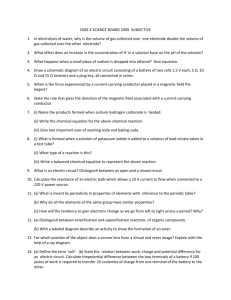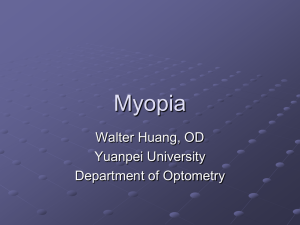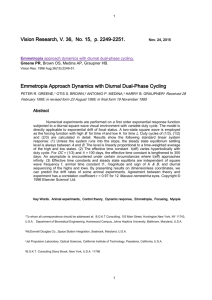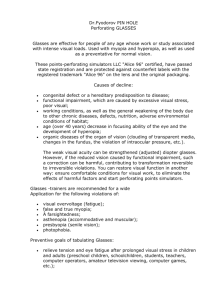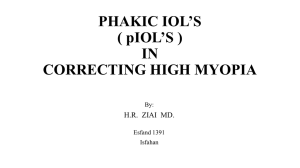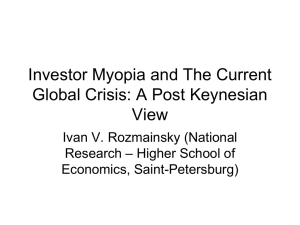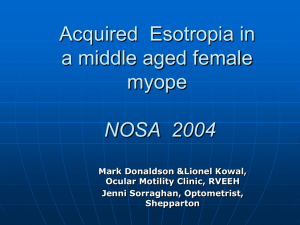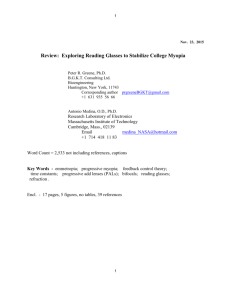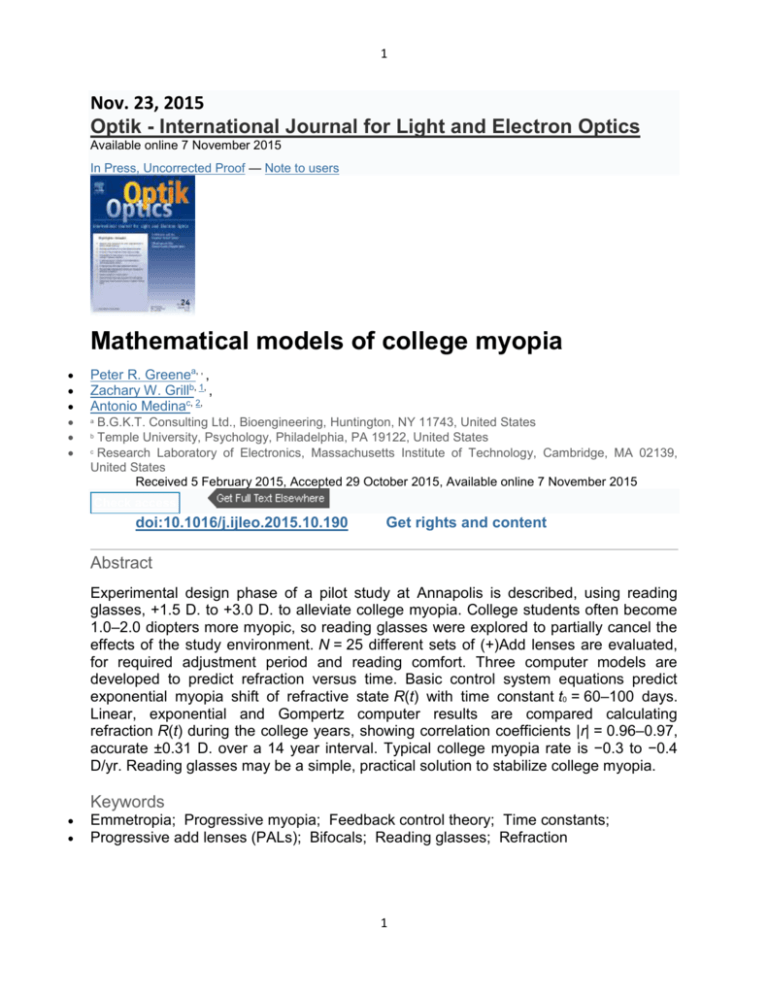
1
Nov. 23, 2015
Optik - International Journal for Light and Electron Optics
Available online 7 November 2015
In Press, Uncorrected Proof — Note to users
Mathematical models of college myopia
Peter R. Greenea, , ,
Zachary W. Grillb, 1, ,
Antonio Medinac, 2,
B.G.K.T. Consulting Ltd., Bioengineering, Huntington, NY 11743, United States
Temple University, Psychology, Philadelphia, PA 19122, United States
c Research Laboratory of Electronics, Massachusetts Institute of Technology, Cambridge, MA 02139,
United States
Received 5 February 2015, Accepted 29 October 2015, Available online 7 November 2015
a
b
Check access
doi:10.1016/j.ijleo.2015.10.190
Get rights and content
Abstract
Experimental design phase of a pilot study at Annapolis is described, using reading
glasses, +1.5 D. to +3.0 D. to alleviate college myopia. College students often become
1.0–2.0 diopters more myopic, so reading glasses were explored to partially cancel the
effects of the study environment. N = 25 different sets of (+)Add lenses are evaluated,
for required adjustment period and reading comfort. Three computer models are
developed to predict refraction versus time. Basic control system equations predict
exponential myopia shift of refractive state R(t) with time constant t0 = 60–100 days.
Linear, exponential and Gompertz computer results are compared calculating
refraction R(t) during the college years, showing correlation coefficients |r| = 0.96–0.97,
accurate ±0.31 D. over a 14 year interval. Typical college myopia rate is −0.3 to −0.4
D/yr. Reading glasses may be a simple, practical solution to stabilize college myopia.
Keywords
Emmetropia; Progressive myopia; Feedback control theory; Time constants;
Progressive add lenses (PALs); Bifocals; Reading glasses; Refraction
1
2
1. Introduction
We helped design an experimental study at Annapolis, using reading glasses, to
reduce college myopia. Navy pilots at Annapolis are required to have 20/20 vision
in order to fly. Many become myopic and therefore must quit the program.
Gmelin [1] reports that approximately 50% of Cadets start as myopic, but the fraction
rises to two-thirds at graduation. In addition to the challenge of just getting the pilots to
graduate, while still maintaining 20/20, we have received reports of a related
phenomenon called “cockpit myopia”, whereby, after close work at the instrument
clusters, maps, instruction manuals, etc., the pilots and co-pilots find distance objects
are blurred. In terms of motivation, some of the successful graduating Ensigns
from Annapolis may, if they are lucky, go on to fly the vertical take-off and
landing (VTOL) AV-8B “Sea Harrier”, or the F-18 “Super-Hornet”, or the even new
F-35 VTOL “Lightning II”. It is difficult enough, trying to land on a pitching carrier deck,
much more so if your vision is reduced to a 20/50 transient myopia during the sortie.
Nearwork induced transient myopia (N.I.T.M.) is reported by some pilots, more so
the navigators, as expected. These various problems, although well defined,
currently have no practical solution. Helmet display and optical design have become
an integral part of aircraft design in recent years (Jenkins and Gallimore [2]). Our
approach involved (+) Add reading glasses, +1.5 to +3.0 diopters, to be used during
long hours of college study to lessen focusing effort (Cheng et al. [3]). In engineering
terms, (+) Add reading glasses (Fig. 1), are considered “optical-offset distance
compensators”, designed to optically shift a book or computer at 13″–20″ to infinity,
thereby easing the focusing work-load on the eye. Reading glasses may be a simple,
practical, solution to stabilize college myopia and pilot myopia.
Fig. 1.
Reading glasses for a −5.00 D. college myope. (+) Add technology is used by both bifocals and
progressive addition lenses, “PAL's”. PAL's are “no-line” bifocals. Basically, these (+) Add glasses
are optical-offset distance compensators, with a +3.00 D Add for reading. Inset shows standard
executive style bifocal with a +3.00 D.Add. for reading.
Figure options
2
3
(+) Add studies require large numbers of students to improve significance
level, discriminating the average diopter difference dR between experimental and
control groups [14]. This difference is not always as pronounced as we might hope
(Cheng et al.[3]). Fulk et al. [4] report N = 42, dR = 0.25 D, p = 0.046, using a +1.50 D.
add. Gwiazda et al. [5] report N > 450, dR = 0.20 D, p < 0.004, using a +2.00 D. add.
Yang et al., [6], using a +1.50 D. add, report N = 149 subjects, dR = 0.25 D, p = 0.01.
Leung and Brown [7] report dR = 0.7 D., p < 0.0001, using = +1.50 D and +2.00
D, N = 36. Cheng et al. [3] report dR = 1.05 D., N = 135, using +1.5 D Add and +1.5D
with prism, p < 0.001. Oakley and Young [8] report dR = 1.0 D, N = 216 ( Fig. 2), using
+1.5 D and +2.0 D Add, p < 0.001 for each of 10 different age brackets. Cheng et
al. [9] and Goss [10] review the literature on (+) Add studies, including bifocal and multifocal lenses.
2. Materials and methods
The design team consisted of 5 consultants, from various universities, ages 30–
60, plus 2 assistants ages 21–30 yrs. Comfort level, feasibility, and endurance factors
were evaluated for the 25 different (+) Add lens combinations (Table 1). In terms of
mathematical theory, 3 computer models of refractive-state shift over an 11–14 year
interval are developed, including linear (Goss and Jackson [11]; Medina et
al. [12a,b]),exponential (Medina and Fariza [12]), and Gompertz (Thorn et al. [13]). Age
matched data sets ( Fig. 2 and Fig. 5), are used to optimize model parameters. Results
are calculated using Basic V. 3.2 and Excel programs. Cheng et al. [3] and
Goss [10] review plus lenses, bifocal, and PAL studies. Typical college myopia rate
is R′ = −0.3 to −0.4 D/yr. Our objective was to reduce the rate to 0.0 D/yr for 4 years.
These myopia rates are typical (Lee et al. [14]; Sun et al. [15]; Lin et al. [16]; Yang et
al. [6]) and also apply to students at the graduate level, some medical schools reporting
myopia prevalence rates greater than 90–95% (Lin et al. [16]). Recently, several (+) Add
research studies have been published (Gwiazda et al. [5]; Leung and Brown, [7]; Fulk et
al. [4]; Oakley and Young [8]; Yang et al. [6]; the COMET Group [17]; Cheng et
al. 0140 and 0170) with encouraging results, i.e. the progressive myopia rate can be
attenuated by 50% or more (Holden et al. [18]) using various (+) Add technologies,
i.e. bifocals and progressive addition lenses (P.A.L.’s) ( Fig. 2). Under proper
supervision, we evaluated an assortment of (+) Add lenses, with powers ranging from
+0.5 D. to +4.0 D. ( Table 1). Tenets of the Helsinki declaration and the internal review
board were adhered to. Comfort level for these reading glasses was such that they are
still in use by most members of the design team.
3
4
Table 1.
(+) Add [D]
1.
2.
3.
+0.5
+1.0
+1.0
+1.5 clip-on lenses
+1.5
bifocal sunglasses
4.
+2.0
5.
6.
+ 2.5 clip-on lenses
+ 3.0
7.
8.
+3.25
+3.5
9.
+4.0
“flipper” lenses −2.0 to +2.0 D
Adapt. time
<1 h
2h
2h
3 h.
3 h.
<1 h
<1 h
1 day
1 day
1 day
1 wk.
1 wk.
n.a.
1 m.
1 m.
1 m.
2 m.
0
Duration
2 yrs.
2 yrs.
0.5 yr.
n.a.
2 yrs.
n.a.
1 wk.
20 yrs.
1 wk.
n.a.
1 yr.
1 wk.
n.a.
1 yr.
1 m.
1 m.
1 yr.
1h
# subj.
1
1
1
3
1
2
1
2
1
3
1
1
2
1
1
1
1
1
Cost
$200
$200
$250
$12
$200
$16
$250
$200
$250
$12
$200
$250
$12
$200
$250
$250
$200
$25
Table options
3. Results
Mathematical models of progressive myopia involve exponential and/or linear
functions. The refractive state as a function of time, R(t) [diopt], of the eye responds, readjusting to the near-point optical demands of a new environment 〈E〉 [diopt.],
typically 〈E〉 = −1 to −2 D. During one semester, refractive state can become
negative, about −0.3 diopters, with a time constant t0 = 60–100 days as:
Eq. (1)
Turn MathJaxon
Similar exponential functions are used by Medina and Fariza [12] and Greene et
al.[19,19a]. In terms of theory, we have explored 3 possibilities in detail: (1) linear
regression (Goss and Jackson [11]) (N = 12); (2) exponential progression (N = 367)
(Medina and Fariza[12]) and (3) the Gompertz function (Thorn et al. [13]), N = 32
iterations. The Gompertz 4-parameter double-exponent is given by:
Eq. (2)
Turn MathJaxon
4
5
where R(t) = refraction at time t. For one subject, we use parameters Re = −0.75 D
initial refraction, Rc = −5.25 D amplitude, onset age t0 = 12 yrs., and a = 0.70 optimal
shape factor, accurate within ± 0.31 diopters. The results for linear regression show
average diopter rate 〈R′〉 = −0.47 D/yr., age at stabilization 22 years, correlation
coefficient r = −0.96. For the exponential model time constant is t* = 3.2–4.4 yrs.,
correlation coefficient r = 0.97, accurate over an 11–14 year interval ( Fig. 2, Fig. 3,Fig.
4 and Fig. 5). Mathematically, the regression model is the easiest to use, the
Gompertz model is the most difficult, but most accurate, and the exponential
model, of intermediate difficulty ( Fig. 2, Fig. 4 and Fig. 5), has the ability to
predict the slower myopia drift after college (for instance, Fledelius [20] reports that
an additional 25% of the students become myopic during graduate school).
Fig. 2.
+2.0 D bifocals (N = 216) can stabilize progressing myopes (N = 367), as indicated by the
horizontal lines. dR = 1.0 D., p < 0.001 for each of 10 age brackets. Otherwise, normal myopia
refraction rates are R′(t = 8 yrs) = −0.7 D/yr, R′(t = 16 yrs) = −0.4 D/yr. Exponential myopia time
constant is t* = 3.2 years.
Figure options
Fig. 3.
5
6
+3.00 D. and +1.00 D. (+) Add lenses for a 49 mm lens barrel. Photo is taken using a +2.00 D. (+)
Add portrait lens, at a distance of 16-inches. These lenses can be added in sequence to the
primary lens.
Figure options
Fig. 4.
Exponential visual system response to a −2.0 D negative step showing delayed myopia onset.
Time constant t0 = 60–100 days.
Figure options
Fig. 5.
Typical college student with progressive myopia, exponential time constant t0 = 4.4 yrs.,
correlation coefficient r = 0.97.
Figure options
3.1. Design team data
From the N = 7 consultants on the design team, 5 are myopes with nominal
spherical equivalent refraction (SER) from −5 to −8 D., two are emmetropes. 4 of the
myopes try and like reading glasses, using various types of (+) Add lenses for an
extended period of time. Myopia can continue to progress beyond the college years
to age 40–45, rarely mentioned in reports (Bullimore et al. [21]; COMET Group [17]).
One myope progresses from −6 to −8 diopt. after college, one myope progresses from
−7 to −8 diopt. after college, 3 myopes remain stable. Bullimore et al. [21] confirm that
36% of adults continue to progress at a rate of −0.75 diopt. per 5-year interval, (ages
>28 yrs., N = 197). Note that the exponential model ( Fig. 4), predicts a slow
continuing myopia drift after the college years, approximately −0.50 D. over a 5
year interval, consistent with the results of Bullimore et al. [21] and Fledelius [20].
6
7
One myope uses progressive (+) Add lenses for 10 yrs., 1 uses bifocals for 20
years, 2 use (+) Add reading glasses for more than 30 years, 1 of the 2 emmetropes
becomes presbyopic, 1 myope has surgery for cataracts, and 1 myope develops a
macular problem in one eye. After starting to use the (+) Add lenses, +1.5 to +2.5 D., all
4 myopes remain stable in terms of refraction, all are older than age 25. Subject
confidentiality is maintained by deleting subject I.D. from the reported records. In
summary, 2 of 3 of our high myopes (|SER| > 6 D.) develop serious vision problems, as
is often reported (Holden et al. [18]; Wong et al. [22]; Goldschmidt [23]), 4 of 5 employ
(+) Add lenses for 10 to 30 years, with refraction remaining stable. This post-graduate
age bracket corresponds to that of pilots, so ordinary reading glasses may be a
simple, practical solution to stabilize pilot myopia.
4. Discussion
There is a natural tendency of the eye to become myopic with long hours
focusing at a near-point environment, confirmed by laboratory experiments (dR = −1.7
D, t = 1 yr.,N = 7, Young [24]). In terms of the (+) Add lenses, to determine appropriate
power level, 25 sets were tried by the design team, +0.50 D to +4.00 D. ( Table 1). After
a variable adjustment period, most find +2.0 D is comfortable and practical,
although the basic equations do suggest stronger values. Typically, bifocals and
PALs are used with progressing myopes with refraction R = −1.0 D to −6.0 D, diopter
rates R′ = −0.2 to −0.8 D/yr thereby slowing these myopia rates by 50% or more
(Holden et al. [18]). PAL and similar studies use multifocal (+) Add lenses ( Fig. 1), for
progressing myopes, of strength +1.00 D. to +2.00 D.
Even the best 35-mm camera, although having excellent range of focus,
would have trouble with the focusing demands of a typical engineering student.
In order to photograph a textbook, a computer screen, an oscilloscope display, or a
blueprint on the drawing board, special close-up so-called “portrait” lenses are required,
typically available in powers of +1.0 D, +2.0 D, and +3.0 D (see Fig. 3) exactly the same
(+) Add values discussed herein. For distances the order of 1.0–1.5 feet, the portrait
lenses can be added in series, in clip-on mode, to achieve +4.0 D, +5.0 D, or +6.0 D.
Usually, there are not enough threads on the lens barrel, to focus up close, so (+) Add
lenses are necessary equipment, even for the best of cameras.
Ultimately, the goal would be to develop and provide standard issue military
grade optical equipment to attenuate the progressive myopia problem. This R & D
effort is quite complicated, far from proven. To date, the only solution has been to
exclude myopes entry into the Academy, beyond a certain level. Initial investigations
went incomplete during 1989–1990 and 1997–1998, similar problems reported by
Gmelin [1]. Another attempt is initiated at another school during 2013. Because of the
proprietary nature of military research, a delay period of a few years is recommended
before reporting results in the public domain, this report meets this requirement. Herein
we report only the practical hardware details found by the design team
evaluating N = 25 (+) Adds ( Table 1). From this list of 25 possibilities, the most
promising are (+) Adds in the range +2.0 to +3.0 diopters, including single vision,
bifocal, and progressive addition PALs.
5. Conclusions
7
8
The purpose of this report is to relate our experiences to clinicians, investigators,
professors, and students, of the various parameters and factors that must be taken into
account when designing a study of this type, using (+) Add technology for the control of
college myopia. Across the board, our most difficult problem has been teaching and
explaining the rationale and strategy of this new optical technique. Unless you
have tried (+) Add reading glasses personally, it remains an abstract concept. Basically,
this is a matter of prescribing reading glasses, normally used by those of age 40+, to
students age 20. Eight successful (+) Add studies reported here (Gwiazda et al. [5];
Leung and Brown [7]; Fulk et al. [4]; Oakley and Young [8]; Yang et al. [6]; COMET
Group [17]; Cheng et al. 0140 and 0170) provide a considerable database for ages 6–
18. Experiments and theory help predict what we may expect to happen, and when,
during the college years. Often overlooked, as an important design parameter, is the
level of the transition line between the distance and near correction in bifocals and
PALs, usually set at 50% of frame height, but to guarantee using the (+) Add segment at
near, it is suggested at the 60–70% level (Prof. Young, personal communication).
Lastly, there is the adjustment period, rarely mentioned in reports,
approximately 1–2 h for a +1.0 D Add, 1–2 days for a +2.0 D Add (20-inches), 1–2
weeks for a +3.0 D Add, and 1–2 months for a +4.0 D Add (10 inches) ( Table 1). As
anyone who has tried contact lenses can tell you, a remarkable degree of bravery, skill,
co-ordination, and persistence are required to learn this task, similar to learning to ice
skate, or to ride a bicycle. (+) Add reading glasses have a similar learning-curve, in
terms of required adjustment time, although considerably easier to use.
The basic strategy of the (+) Add technique is to reduce the focusing demand on
the visual system during prolonged study, (n.b. – 13″ reading dist. = −3.0 diopt.
accommodative demand). There are several reports of myopia developing with Navy
submariners, and extensive LASIK use in the Army (Hammond et al. [25]), to cure the
myopia problem, more than 16,000 recruits as of 2003, a total of 26,000 recruits as of
2005. The Annapolis Navy pilots are required to be in excellent physical condition, it is a
demanding job flying a Mach 2 fighter/bomber. These various (+) Add lenses effectively
shift a book or computer at 13″–20″ to infinity. Various types of reading glasses, i.e.
single vision, bifocals, and the new multi-focal progressive lenses (PALs), may be a
practical way to stabilize college myopia and pilot myopia.
Conflict of interest statement
The authors have no conflicts of interest.
Acknowledgements
Assistance was provided by discretionary research funds at the U.S. Naval Academy,
Annapolis, MD, and The Johns Hopkins University, Baltimore, MD, C & O
Publishing, Personal Optics Co., Towson Rotunda Optics, and BGKT Consulting
Engineers.
8
9
REFERENCES
[1] R.T. Gmelin, Myopia at West Point: past and present, Mil. Med. 141 (8), 1976, 542–543.
[2] Jenkins J.C. and Gallimore J.J., Configural features of helmet-mounted displays to enhance pilot
situation awareness,Aviat Space Environ. Med. 79 (4), 2008, 397–407.
[3] D. Cheng, G.C. Woo, B. Drobe and K.L. Schmid, Effect of bifocal and prismatic bifocal spectacles
on myopia progression in children: three-year results of a randomized clinical trial, JAMA
Ophthalmol. 132 (3), 2014, 258–264.
[4] G.W. Fulk, L.A. Cyert and D.E. Parker, A randomized trial of the effect of single-vision vs. bifocal
lenses on myopia progression in children with esophoria, Optom Vis. Sci. 77 (8), 2000, 395–401.
[5]J. Gwiazda, L. Hyman, M. Hussein, D. Everett, T.T. Norton, D. Kurtz, M.C. Leske, R. Manny, W.
Marsh-Tootle and M. Scheiman,A randomized clinical trial of progressive addition lenses versus
single vision lenses on the progression of myopia in children, InvestOphthalmol.
Vis. Sci. 44 (4), 2003, 1492–1500.
[6] Z. Yang, W. Lan, J. Ge, W. Liu, X. Chen, L. Chen and M. Yu, The effectiveness of progressive
addition lenses on the progression of myopia in Chinese children, Ophthalmic
Physiol. Opt. 29 (1), 2009, 41–48.
[7] J.T. Leung and B. Brown, Progression of myopia in Hong Kong Chinese schoolchildren is slowed
by wearing progressive lenses,Optom. Vis. Sci. 76 (6), 1999, 346–354.
[8]
K.H. Oakley and F.A. Young, Bifocal
Physiol. Opt. 52 (11), 1975, 758–764.
control
of
myopia, Am
J.
Optom.
[9] D. Cheng, G.C. Woo and K.L. Schmid, Bifocal lens control of myopic progression in children, Clin
Exp. Optom. 94 (1),2011, 24–32.
[10] D.A. Goss, Effect of spectacle correction on the progression of myopia in children-- – a literature
review, J. Am. Optom. Assoc. 65 (2), 1994, 117–128.
[11] D.A. Goss and T.W. Jackson, Cross-sectional study of changes in the ocular components in school
children, Appl. Opt. 32 (22),1993, 4169–4173.
[12]
Medina A. and Fariza E., Emmetropization
system, Vis. Res. 33 (1), 1993, 21–26;
as
a
first-order
feedback
(a) Medina A. and Greene P.R., Progressive myopia and lid suture myopia are explained by the
same feedback process: a mathematical model of myopia, J. Nat. Sci. 1 (6), 2015, pii: e121;
(b) Medina A., The
progression
of
Exp. Ophthalmol. 253 (8), 2015,1273–1277.
corrected
myopia, Graefes
Arch
Clin.
[13] F. Thorn, J. Gwiazda and R. Held, Myopia progression is specified by a double exponential
growth function, Optom. Vis.Sci. 82 (4), 2005, 286–297.
[14] J.H. Lee, D. Jee, J.W. Kwon and W.K. Lee, Prevalence and risk factors for myopia in a rural
Korean population,Invest. Ophthalmol. Vis. Sci. 54 (8), 2013, 5466–5471.
[15]Sun J., Zhou J., Zhao P., Lian J., Zhu H., Zhou Y., Sun Y., Wang Y., Zhao L., Wei Y., Wang L., C
un B., Ge S. and Fan X., High prevalence of myopia and high myopia in 5060 Chinese university
students in Shanghai, Invest. Ophthalmol. Vis. Sci. 53 (12), 2012, 7504–7509.
9
10
[16] Lin L.L., Shih Y.F., Lee Y.C., Hung P.T. and Hou P.K., Changes in ocular refraction and its
components
among
medical
students– a
5-year
longitudinal
study, Optom.
Vis. Sci. 73 (7), 1996, 495–498.
[17] COMET Group, Myopia stabilization and associated factors among participants in the Correction
of MyopiaEvaluation Trial (COMET), Invest Ophthalmol. Vis. Sci. 54 (13), 2013, 7871–7884.
[18] Holden B., Sankaridurg P., Smith E., Aller T., Jong M. and He M., Myopia, an underrated global
challenge to vision: where the current data takes us on myopia control, Eye
(Lon)) 28 (2), 2014, 142–146.
[19] P.R. Greene, O.S. Brown, A.P. Medina and H.B. Graupner, Emmetropia approach dynamics with
diurnal dual-phase cycling, Vis Res. 36 (15), 1996, 2249–2251;
a) P.R. Greene, E.S. Vigneau and J. Greene, Exponential prevalence and incidence equations
for myopia, Clin. Exp. Optom. 98 (3), 2015, 210–213.
[21] H.C. Fledelius, Myopia profile in Copenhagen medical students 1996–98. Refractive stability
over a century is suggested Fledelius HC.*(1), Acta Ophthalmol. Scand. 78, 2000, 501–505, Am.
J. Ophthalmol. 2001 Jan;131(1):156.
[21] M.A. Bullimore, L.A. Jones, M.L. Moeschberger, K. Zadnik and R.E. Payor, A
retrospective
study of myopia progression in adult contact lens wearers, Invest. Ophthalmol.
Vis. Sci. 43 (7), 2002, 2110–2113.
[22] T.Y. Wong, A. Ferreira, R. Hughes, G. Carter and P. Mitchell, Epidemiology and disease burden
of pathologic myopia and myopic choroidal neovascularization: an evidence-based systematic
review, Am. J. Ophthalmol. 157 (1), 2014,9–25, e12.
[23] E. Goldschmidt, The mystery of myopia, Acta Ophthalmol. Scand. 81 (5), 2003, 431–436.
[24] Young Fa., The effect of restricted visual space on the refractive error of the young monkey
eye, Invest. Ophthalmol. 2, 1963, 571–577.
[25]
M.D. Hammond, W.P. Madigan, Jr. and K.S. Bower, Refractive surgery
States Army, 2000–2003,Ophthalmology 112 (2), 2005, 184–190.
in
the
United
Corresponding author. Tel.: +1 631 935 56 66; fax: +1 631 427 95 45.
1
Tel.: +1 516 864 96 15.
2
Tel.: +1 714 418 11 83.
Copyright © 2015 Elsevier GmbH. All rights reserved.
Note to users: Uncorrected proofs are Articles in Press that have been copy edited
and formatted, but have not been finalized yet. They still need to be proof-read and
corrected by the author(s) and the text could still change before final publication.
Article available at :
10
11
Greene, Peter R., Zachary W. Grill, and Antonio Medina. "Mathematical Models of College
Myopia", Optik - International Journal for Light and Electron Optics (2015), 129(2), 896-899.
Mathematical models of college myopia,
Peter R. Greene, Zachary W. Grill, Antonio Medina Abstract,
Original Research Article, Pages 896-899
Purchase PDF - $41.95
End of Word File
11
11 / 23 / 2015

